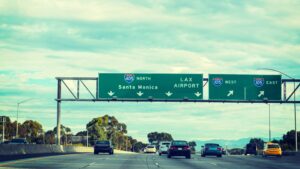Rideshare Accidents in California
November 16, 2022
Executive Summary
If you’ve been in an accident involving an Uber/Lyft vehicle, you may have a claim.
- Uber and Lyft carry substantial third-party liability insurance. The amount of coverage available depends on the stage of the ride (before, during, or after the trip).
- The value of your claim depends on many things, including the party responsible and the severity of your injuries.
- No matter how simple the claim seems, the process can be difficult and time-consuming. It’s a good idea to consult an experienced attorney before proceeding.
Rideshare Accidents Happen Often
When was the last time you called a taxi? Today, many Californians would prefer to hail a ride through the Uber or Lyft apps. There may be nothing wrong with traditional yellow cabs, but the ease of scheduling a ride from a smartphone is hard to pass up.
In California, the market dominance of rideshare companies like Uber and Lyft (also called Transportation Network Companies, or “TNCs”) is hard to overstate. According to an analysis by the University of California Riverside School of Business, “around 1.37 million drivers . . . performed at least one ride or delivery across the DoorDash, Instacart, Lyft, and Uber platforms in California.”[i] Excluding food delivery, there were about 600,000 rideshare vehicles on California roads in 2018,[ii] including 40,000 in Los Angeles alone.[iii] And in less than one year, gross driver earnings “totaled $4.3 billion across the platforms.”[iv]
It’s not hard to guess why TNCs have become so successful: they provide a simple, easy-to-use service that eliminates the need to drive yourself. Need a ride to the airport and don’t want to pay for parking? Call an Uber. Had a few drinks at dinner and want to be safe? Call a Lyft. But don’t forget, you’re still in a car. Even though you are not behind the wheel, you face many of the same risks as if you were. And on Los Angeles roads, accidents happen. Often.
If you have been in an accident and an Uber, Lyft, or other TNC vehicle was involved, you have rights. This article will discuss what to do in an accident and how to pursue your claims afterward.
Immediately After Accident
If you’ve been in an accident, whether or not a TNC vehicle was involved, the first thing you should do is stop and check yourself and others for injuries. If someone requires medical attention, call 911 immediately. Even if you’re not sure that someone needs medical attention, it is best to call 911 to be safe. Once you’ve done that, follow these steps:
- Notify the police.
- Write down the names, addresses, telephone numbers, driver’s license numbers, and insurance information of all parties involved. Everyone involved in the accident must provide you (or the police) with this information, and you are under the same obligation. (Note: Don’t forget to obtain this information from your TNC driver if you were a passenger.)
- Write down the license plate numbers of all vehicles involved. If possible, ask to see the vehicle registration documents as well.
- Take photographs of all vehicles involved, any injuries you have sustained, all traffic control devices nearby (stop signs, stop lights, speed limit signs, etc.), and all obstacles in the roadway (like trash, tire treads, or construction).
- Write down the names, addresses, and telephone numbers of any witnesses.
- Write down your own recollection of events as soon as possible, as people’s memories of traumatic events fade with time.
- Notify your insurance.
- Notify the DMV within 10 days.
Do I Have a Claim?
If you’ve been in an auto accident involving a TNC vehicle (like an Uber or Lyft), you may have a claim. This is especially true if you suffered an injury requiring medical treatment, had to take time off of work, or if your valuable property was damaged. However, the nature and value of your claim may vary and can involve complex legal questions.
Generally, claims can be broken down into three categories: economic damages, non-economic damages, and punitive damages:
Economic damages are tangible financial losses. In auto accidents, they typically include medical bills, property damages, lost wages, reduced earning capacity, and other losses whose value is readily calculable.
Non-economic damages may include pain and suffering, emotional distress, and loss of consortium.
Punitive damages are any damages over and above economic and non-economic damages that may be awarded to punish the responsible party for behavior that is particularly reprehensible.
Depending on the circumstances of your accident and the extent of the injuries you have sustained, some or all of these damage categories may apply to you.
What is My Claim Worth?
It can be difficult to determine the value of your claims after any accident. In an accident involving a TNC vehicle, your claim could be worth anywhere from a few thousand dollars to more than a million dollars. The exact number will depend on the circumstances of the accident, who was responsible, and how severe your injuries were.
Who is Responsible?
Once you’ve determined that you have a claim, the next step is to consider who may be responsible. Below are a few examples:
Injured Passenger in a TNC Vehicle: If you were a passenger in a TNC vehicle that was involved in an accident, you might have claims against the adverse driver, the TNC driver, the TNC Company itself, and anyone else involved in the accident.
Injured Driver in Another Vehicle: If you were the driver of a personal vehicle and that vehicle was involved in an accident with a TNC vehicle, you might have claims against the driver of the TNC vehicle, the TNC company, and anyone else involved.
Injured Passenger in Another Vehicle: If you were the passenger in a personal vehicle that was involved in an accident with a TNC vehicle, you might have claims against both drivers, the TNC company, and anyone else involved.
Injured Pedestrian Struck by TNC Vehicle: If you were a pedestrian injured by a TNC vehicle, you might have claims against the TNC driver, the TNC company, and anyone else involved.
Though it may seem simple, determining who was at fault can be a difficult task. In any of the examples above, more than one party may be responsible for the accident.
Who Will Pay for My Injuries
Generally speaking, the party responsible for the accident will be financially responsible for the resulting injuries. California allocates responsibility in these accidents using a “pure comparative negligence” system.[v] That means the at-fault parties are financially responsible for their share of the blame. However, because California requires all drivers to carry liability insurance,[vi] it is typically the insurers who will ultimately pay your claim. Therefore, pursuing your rights after an accident usually involves working with the relevant insurers. This is not always easy, as demonstrated in the examples below:
At-Fault Driver Has Sufficient Coverage: If the at-fault driver holds a liability policy that is big enough to cover all of your injuries, then the process of recovery may be somewhat straightforward. For example, if you are the passenger in a TNC vehicle that was hit by another vehicle, and the other vehicle was 100 percent at-fault, then you can file a claim against the other driver’s insurer. If the other driver has a $100,000 policy, and you suffered only $10,000 in damages, then that driver’s policy might pay for the entirety of your claim. Remember, though, that the responsible driver may not admit fault.
At-Fault Driver Has Insufficient Coverage: Often, the at-fault driver will not have enough insurance coverage to pay for your entire claim. California requires drivers to carry a policy whose limits are at least:
$15,000 for one injured or killed person
$30,000 for two or more injured or killed persons
$5,000 for property damage.[vii]
These minimum limits policies (called “15/30/5 policies”) are quite common. If the at-fault driver has a policy that is insufficient to cover your injuries, then you must turn somewhere else to make up the difference. Many people (and many of the TNC companies) carry what’s called uninsured/underinsured motorist coverage (also called “UM/UIM coverage”). If the at-fault driver does not have enough insurance to cover your injuries, then you may turn to your own insurance (if you have such a policy), or that of the TNC company.
At-Fault Driver Has No Coverage: According to one study, 16.6% of California drivers are uninsured.[viii] If the at-fault driver is entirely uninsured, then you may have to rely on your own UM/UIM coverage (or that of the TNC company) for your entire claim.
How Much Insurance Do Uber and Lyft Have?
If you’ve been in an accident involving a TNC vehicle like Uber or Lyft, there is a good chance that you will have to deal with their insurers at some point. Below are the types of coverage that may be available.
Uber/Lyft Primary Liability Coverage Kicks In: Uber and Lyft maintain various liability policies and navigating them can be tricky. Generally speaking, the amount of coverage available depends on the “phase” of the ride:[ix], [x]
Phase 1 – Driver’s App is Off: If the driver’s app is off and he or she does not have a passenger, then the driver’s personal auto insurance will be responsible for any injuries sustained in an accident. Keep in mind, this could be the minimum coverage (15/30/5) policy discussed above.
Phase 2 – Driver is Awaiting a Request: If the driver is available or awaiting a ride, then Uber and Lyft maintain third-party liability policies with the following limits:
Uber
$50,000 per person for bodily injury; maximum of $100,000 per accident
$30,000 for property damage
Lyft
$50,000 per person for bodily injury; maximum of $100,000 per accident
$25,000 for property damage
Note: Phase 2 coverage will only take effect if the driver’s personal auto insurance policy does not apply, or if the driver’s personal policy provides less coverage than the limits above.
Phase 3 – Driver Has Accepted Ride/Ride in Progress: If the Uber or Lyft driver has accepted a ride or a ride is in progress, then the companies each maintain a $1,000,000 third-party liability policy (combined bodily injury and property damage).
Uber maintains similar coverage limits for accidents involving UberEats and Postmates (owned by Uber) delivery drivers.[xi] DoorDash maintains liability coverage only while the driver is on an active delivery, and the coverage limits are not publicly available.[xii] Grubhub does not provide any sort of liability coverage.
Uber’s UM/UIM Policy Kicks In: Uber also maintains an uninsured/underinsured motorist policy that may cover bodily injuries if the at-fault driver does not have sufficient coverage.[xiii] Typically, this policy will only kick in when the driver has accepted a ride or a ride is in progress. Unfortunately, Uber does not disclose the coverage limits for this policy to the public.
Conclusion
The ubiquity of drivers and the seamless nature of app-based ride-hailing make the process seem nearly automatic: open app, order ride, arrive at your desired destination. But that process is missing a critical step: driving. In the back seat of an Uber or Lyft, one must remember the simple truth: you are still in a car that is operating on public roads.
We hope that your experience with ridesharing apps like Uber and Lyft is safe, easy, and uneventful. But if something goes wrong, Mann Legal Team is here to help. Taking on big companies like Uber and Lyft can seem daunting, but our team is not afraid. Know your rights and enjoy the ride.
Contact the experienced attorneys at Mann Legal Team, Inc. for a free consultation.
 |
James D. White |
References
[i] https://protectdriversandservices.com/wp-content/uploads/2022/03/UCR_CEFD_CA_AppDrivers_Analysis_2_17_2022-41.pdf
[ii] https://www.latimes.com/opinion/story/2021-10-20/taxi-uber-lyft-rideshare-cost
[iii] https://www.latimes.com/california/story/2022-02-16/can-l-a-save-its-taxi-industry-its-trying-to-with-new-apps-expanding-permits
[iv] https://protectdriversandservices.com/wp-content/uploads/2022/03/UCR_CEFD_CA_AppDrivers_Analysis_2_17_2022-41.pdf
[v] Li v. Yellow Cab Co., 13 Cal. 3d 804 (1975).
[vi] See Cal. Ins. Code § 11580.1(b)(1); Cal. Veh. Code § 16056(a).
[vii] See id.
[viii] https://www.iii.org/fact-statistic/facts-statistics-uninsured-motorists
[ix] https://www.uber.com/us/en/drive/insurance/; https://uber.app.box.com/s/akofllm30jvoef56cidusw1v2386o4gy
[x] https://help.lyft.com/hc/e/all/articles/115013080548-Insurance-coverage-while-driving-with-lyft
[xi] https://www.uber.com/us/en/drive/insurance/
[xii] https://help.doordash.com/dashers/s/article/Does-DoorDash-have-auto-insurance?language=en_US
[xiii] https://www.uber.com/us/en/drive/insurance/
© Copyright 2021. MANN LEGAL TEAM All rights reserved.
